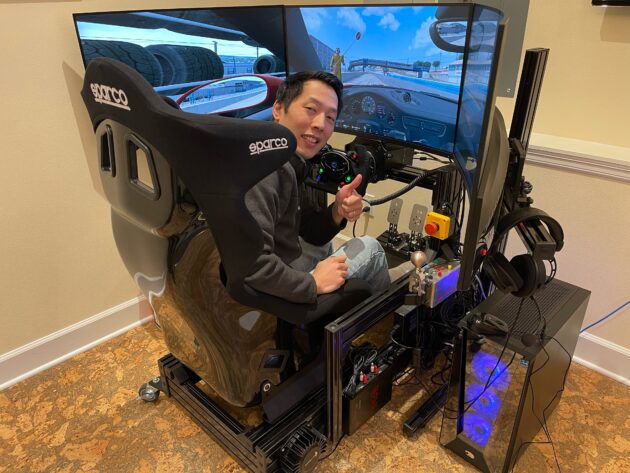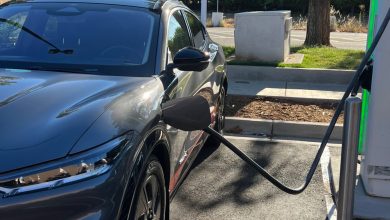Pedal to the metaverse: This Seattle techie discovered real-world ache driving on a simulated racetrack

Frank Chang loves to drive fast. When he races, he can feel the vibration of the road beneath him, the g-forces and steering tension in tight turns, and the exertion that comes with repeated braking and accelerating.
Climbing out of a race car unhurt is a victory in and of itself.
Climbing out of his racing simulator with a recent injury was a surprise.
‘On the one hand, yeah, it sucks to hurt yourself. But on the other hand, I came away from it thinking the simulation is quite realistic.’
Chang, 45, is a tech veteran who spent 16 years at Microsoft and a couple more at Amazon before becoming a co-founder and managing partner at Flying Fish Partners, a Seattle venture capital firm. For 20 years, Chang has been racing a variety of cars at tracks all over the country.
A few weeks ago he was training for an upcoming race at Circuit of the Americas, a track outside Austin, Texas. Like many driving fanatics and even professionals, Chang uses a tricked-out home simulator and practices on race courses in the online video game iRacing.
“I’ve never been there so I wanted to kind of learn the track and drive it in the virtual world before I drive it in the real world,” Chang said of his COTA practice session. After a couple hours, he felt like he’d already been to Texas.
“In real life when you race a car, you can get pretty tired and you can hurt yourself,” he said. “You can end up tweaking your back or pulling muscles or whatnot. Basically the same thing happened while driving the simulator.”
Chang’s strained back seems like a far cry from the subjects in those “fail videos” which are all over YouTube and social media feeds. As more people have waded into the so-called metaverse to find entertainment, they’re tripping over and stumbling into things in the real world — and getting hurt in the process.
The Wall Street Journal — in a piece headlined “VR to the ER” — reported this month on the accident prone early adopters of the metaverse who are breaking everything from vases and TVs to their own shoulders, kneecaps and more.
With interest in virtual reality devices growing, “so is their reputation for being a source of pain and embarrassment,” the Journal said.
Facebook parent company Meta has staked its future on the 3D-connected evolution of the internet. Judging by holiday sales this year, the Meta Quest 2 headset appears to be doing more than its part to bring virtual reality into the mainstream. The company’s recent quarterly earnings revealed that the Oculus app reached No. 1 in the App Store for the first time on Christmas Day and people have spent more than $1 billion on Quest store content.
“The health and safety of people who use our Quest devices is our highest priority and it’s important for all new users to review the health and safety information included in our device packaging, online, and during device set-up,” Meta said in a statement accompanying tips from its Oculus Safety Center.
Chang’s simulator is like those at GripWerx Racing in Redmond, Wash., where car enthusiasts can get “a hyper realistic driving experience using the latest cutting-edge simulation technology and hardware.”
His set-up features an assortment of components, including a PC and wraparound monitors. A real racing seat is enhanced with haptics powered by transducers bolted to a frame that holds the seat. The pedals are spring loaded with adjustable pressure. The steering wheel has a strong direct-drive hub motor.
“I’ve heard stories of people hurting their wrists, because if you crash in simulation, it’ll whip the wheel around,” Chang said. “It’s quite realistic in terms of the physics of everything.”
He doesn’t wear a virtual reality headset because he’s prone to motion sickness, but he knows some people do, or they wear a helmet and full racing kit to further enhance the simulation.
But based on the people in those fail videos and the busted-up subjects of the Journal story, not enough people are clearing a safe space or moving pets and people out of the room before going into another reality.
Harborview Medical Center in Seattle was unable to provide any useful statistics on how many people visit its emergency room for metaverse and VR-related injuries. The hospital does not capture patient injury information at such a granular level.
Chang didn’t require a hospital visit for his tweaked back. His wife is a doctor who advised him on some stretches to do. He took some Advil and he was feeling better and ready to race for real.
“On the one hand, yeah, it sucks to hurt yourself. But on the other hand, I came away from it thinking the simulation is quite realistic,” Chang said. “It’s cool and the pain is just sort of part of it. You can pull muscles in the simulated world just like you can in the real world.”
Asked if he learned any other lessons from the experience, Chang confirmed that you can’t outrace getting older.
Conclusion: So above is the Pedal to the metaverse: This Seattle techie discovered real-world ache driving on a simulated racetrack article. Hopefully with this article you can help you in life, always follow and read our good articles on the website: Doshared.com




